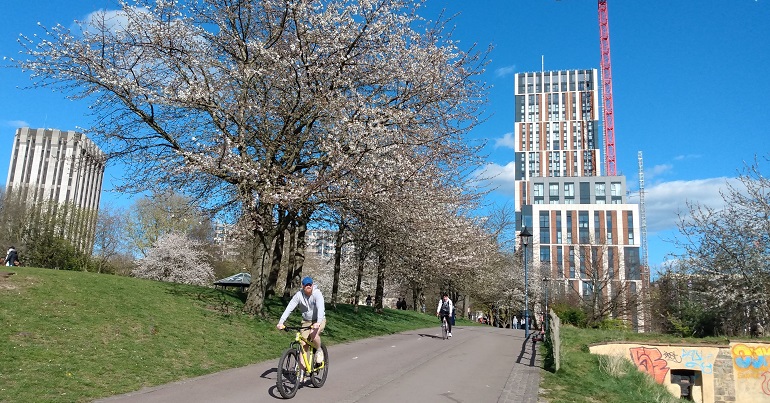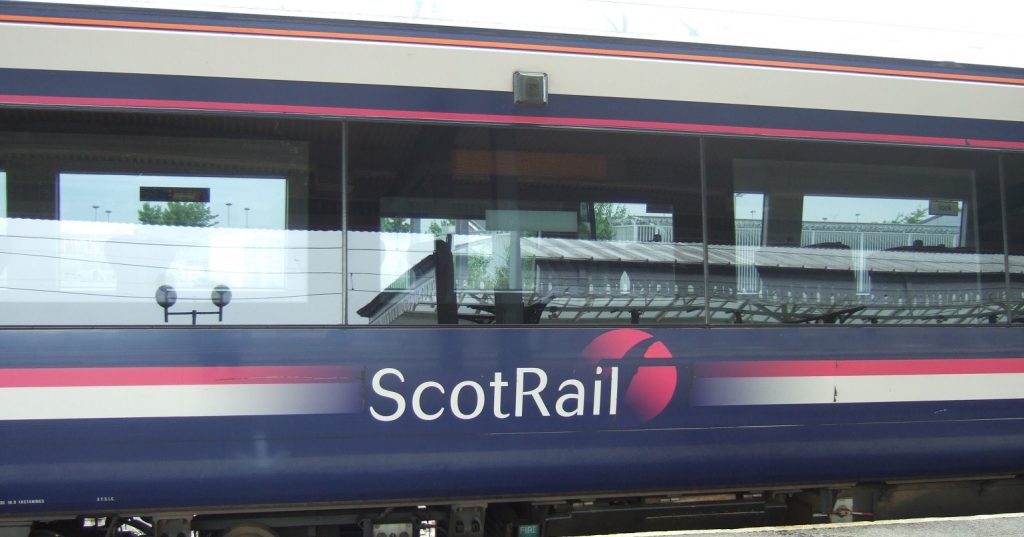Can we stop 20 years of urbanisation from unravelling?

20 years ago, a little-noticed change in government policy helped to radically transform British cities, mainly for the better. Today we stand at another pivotal point, where many of those gains might unravel. Can the lessons of that 20-year old experiment help us to choose a better path for post-COVID recovery?
That government policy had the snappy title PPG13 – Planning Policy Guidance on transport. It followed a similar policy on housing, published a year earlier, during the brief period when John Prescott’s superministry tried to integrate transport and spatial planning. A brownfield-first policy, higher densities and maximum parking standards were all designed to concentrate development in cities and restrain the seemingly inexorable growth in motor traffic. Local Government Chronicle quoted a junior minister explaining technical details about transport assessments and parking standards. Nothing in the article suggested a social revolution, which those policies would help to ignite. The mainstream media completely ignored PPG13.
Only with several years of hindsight did the impact of those policy changes become clear. The decades-long depopulation of cities went into reverse, led by young adults and high-density redevelopment of urban brownfield sites. The market and demographic trends were favourable but the timing of the changes, and differences between England and Scotland, leave no doubt that government planning policy was a major cause; between 2001 and 2007 the average density of new housing development in England increased by 72%. From the mid-2000s onwards, car-borne traffic began to fall, several years before the recession accelerated the process. As I have explained elsewhere, those policy changes were an important cause of that fall in traffic generation – particularly amongst young adults.
They also slowed down the speed at which England (in particular) had been eroding what remained of its countryside. The conventional wisdom of politicians, property developers and the media says that only 10% of England has been built on – building on a bit more “won’t destroy the countryside”. As I explain in this article, that argument is spurious. Small increases in urbanisation cause disproportionate environmental damage, particularly when they are accompanied by road building or road widening.
Today there are disturbing signs in the housing market of a flight from the cities, as people seek more space for home working and greater distance from their neighbours. Public transport use has collapsed, and many people say they intend to use it less in the future. By late September traffic volumes had returned to pre-pandemic levels despite the fact that only half the working population was commuting. In a normal year travel to work only accounts for one journey in six. Most travel is for private purposes, which are likely to return with exuberance when COVID restrictions come to an end.
Some of the factors driving future change are uncertain and uncontrollable; how long will COVID-19 (or future pandemics) cause people to shun close contact with others? The future of public transport will critically depend on that. Two changes seem inevitable, however. The pandemic will clearly accelerate long-running trends towards home working and online shopping, with several implications for cities and travel patterns. Travel in and out of city centres will not return to pre-COVID levels, whilst travel elsewhere is likely to rise. Occupation of shop and office space in city centres has already begun to shrink and is unlikely to bounce back any time soon. How different authorities respond to that threat, or opportunity, will determine whether people look back at 2021 as a transition towards decline or renaissance.
How might city centres regain their vitality? On that question past research is of limited use. This report published by the Centre for Cities in 2019, explaining how high-skilled office jobs support more retail, reads like a historical document today. As those activities inevitably shrink or move elsewhere, city centres may decline or they may become more cultural, leisure-oriented and residential. The Greater London Authority seems to appreciate this, but there is a risk that elsewhere vested interests might engage in a hopeless struggle to bring back ‘business as usual’, by trying to block the conversion of redundant space, for example.
Housing is one obvious, and necessary, use for redundant space, providing cities make their centres – and the areas surrounding them – attractive places to live. On this I am writing partly based on my own experience. Eleven years ago, we moved from rural Devon to Bristol city centre in order to live a more sustainable lifestyle, swapping a house for a flat and getting rid of the car. One peculiarly British problem I have noticed is a deep-seated prejudice amongst planners, policymakers and businesses that city centres are purely commercial assets for outsiders. This is often linked to a misconception that most housing is, or ought to be, for families. In fact, two-thirds of UK households contain just one or two people and adults sharing make up many of the rest. In that context, some city centres, like Bristol, have already become densely-populated residential areas; they must become more so in future, and councils must attach greater weight to the interests of their residents over business owners.
A long-standing clash of interests concerns through-traffic and air pollution. I had never experienced breathing problems until I moved here, and I have been fine during the lockdowns. For several years I ran a campaign to remove through traffic from the city centre – the pandemic finally emboldened Bristol City Council to do that.
Another issue frequently raised during the pandemic has been lack of outdoor space – a particular problem for offices converted to flats under the permitted development rights, which might now extend to retail buildings. If cities convert buildings to residential use, where can they find additional outdoor space for the new residents? There are only two possibilities: land currently occupied by roads and parking.
One lesson learnt from the early 2000s, which still applies today, is that urban regeneration and greenfield conservation are critically inter-dependent. If national and local government allow a market-led acceleration of greenfield building, they will undermine the recovery of cities, the management of travel demand and the decarbonisation of the UK economy.
Steve Melia is a Senior Lecturer in Transport and Planning at the University of the West of England. His latest book, Roads, Runways and Resistance – from the Newbury Bypass to Extinction Rebellion is published by Pluto Press.
PS. We hope you enjoyed this article. Bright Green has got big plans for the future to publish many more articles like this. You can help make that happen. Please donate to Bright Green now.
PPS. Bright Green has an exciting series of events coming up. Join us for debates, interviews and much more.




Very interesting article. Thanks. Particularly like the idea of converting roads and parking into green space. Big changes in retail on the horizon. Fascinating to see what actually happens to our city centres once this pandemic has finished in a couple of years time. Certainly won’t be a return to mass commuting to “the office”. But without rural bus services the countryside might become a place with two even more segregated populations. The mobile wealthy and the trapped poor.
In response to Dave (are you the same Dave that misread the chart in my previous article?) I want to clarify some statistics and sources.
There are different measures of land cover, which produce different estimates. That quote about 10% of England being built on refers to a statistic often used in political debate. The original statistic came from the UK Environmental Accounts. See for example:
https://www.bbc.co.uk/news/uk-18623096
The latest ONS estimates for land cover show that 8% of the UK is built on. England is, of course, more densely populated:
https://www.ons.gov.uk/economy/environmentalaccounts/bulletins/uknaturalcapital/urbanaccounts
I was looking for a simple chart to illustrate the point about the depopulation and repopulation of cities. There is one, but it is behind a paywall, unfortunately. I quote from the article cited below. The depopulation was relative i.e. as a proportion of the population (and the density of cities, which were physically expanding). In some cases, such as London and Liverpool there had been an absolute reduction in population, but for UK cities as a whole there was a relative reduction which ended at around that time.
https://www.tandfonline.com/doi/abs/10.1080/01441647.2013.802751
Figure 2 shows the proportion of the population living in the grouped area types over the same 40 year period [1971 – 2011]. Again a distinct pattern is evident with the area-types 7–11 [smaller settlements] gaining population share up to 2001 and the more urbanised types 1–6 slowing their earlier decline with Greater London actually increasing its share
since 1991. The more recent changes in population share reflect the reversal of previous decline in absolute numbers which occurred in London and many other cities. Since the built-up boundary of these cities is generally unaltered (due to planning policies of urban containment), their population density has undergone a similar reversal of previous decline. This trend corresponds with that which has been observed in a range of cities in developed countries (Newman & Kenworthy, 2011).
“The decades-long depopulation of cities”
Er… That never happened. If your thesis relies on something like that, surely you’d check the figures?
Depopulation – or rather migration – has indeed emptied out the North of the UK. Over 30% of the UK’s population has moved south in a bit under a century. Empty cities ‘oop north’ go with the empty countryside towns and villages. London, Birmingham (and Derby, Peterborough, Ipswich etc) have grown in that time.
The proportion of the UK population living in cities has risen, in total, in the timeframe referred to.
“The conventional wisdom of politicians, property developers and the media says that only 10% of England has been built on”
I’m not sure how that’s relevant. The _ONS_ has actual numbers and puts it at <8%.
This bit's simply wrong, too:
"If cities convert buildings to residential use, where can they find additional outdoor space for the new residents? There are only two possibilities: land currently occupied by roads and parking."
There are more than two possibilities. Some more outlandish than others. Demolition of buildings, construction of rooftop gardens, aerial parks, and so-on.
Ultimately, quibbling aside, I agree we need to get the big vehicles off roads in urban areas. Once we manage that, then we can all quite happily ride bicycles, scooters, mopeds, and what-have-you without fear of being crushed.
I think, at least as far as London is concerned, there was at least one other key factor and that was the increase in school funding under Labour which meant less middle-class flight to the ‘burbs.